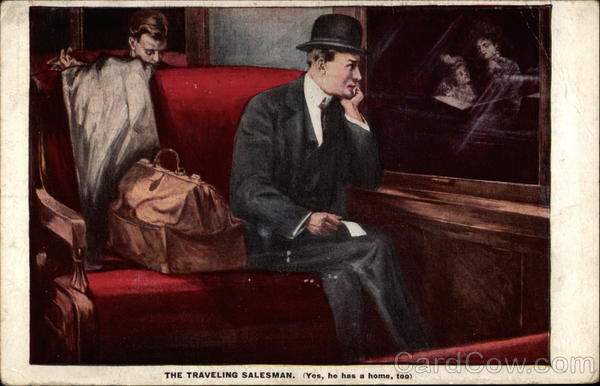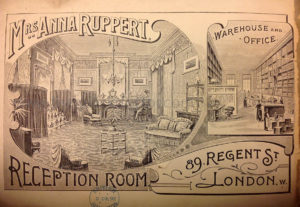 The life of a travelling salesman in the early 20th century US might have involved stuffy railway carriages, soulless hotels and rejection by jaded druggists, but that doesn’t mean there were no lighter moments.
The life of a travelling salesman in the early 20th century US might have involved stuffy railway carriages, soulless hotels and rejection by jaded druggists, but that doesn’t mean there were no lighter moments.
The reports of the Illinois Pharmaceutical Travelers’ Association, established in 1903, give a delightful glimpse into the fun and games to be had at its annual meeting – where the bureaucratic essentials found their balance in such unmissable events as the Fat Man’s Race and the Single vs Married Ladies Tug-of-War.
The Travelers formed an auxiliary organisation of the Illinois Pharmaceutical Association, intended to bring commercial salespeople under the IPA’s aegis and to increase its membership by ‘selling’ the advantages to the druggists they visited. An even more important part of the Travelers’ remit, however, was to arrange the entertainment at the yearly summer convention, where druggists and salesmen could network with each other and engage in friendly rivalry.
The convention had its official purpose, of course, but once the AGM was out of the way, it was time for sightseeing, dining, smoking and enjoying the all the vibrancy and humour the patent medicine trade had to offer. As well as excursions to local places of interest and card parties for the delegates’ female companions, the highlight of the convention was Gala Day.
In the first year of the Travelers’ existence, 1903, they did the Association proud with a programme of amusements at Miller Park, Bloomington, IL. Attendees could compete for valuable prizes in contests that must have been a hoot to behold, especially after a hearty picnic in the sunshine and more than a few swigs from a hip flask. As most of the prizes were donated by the manufacturers of commercial pharmaceuticals, the winners could find themselves in possession of such covetables as Tanglefoot Fly Papers or a case of Dr Kilmer’s Swamp Root.
Some of the competitions called upon talents specific to the trade – in 1904, for example, Fred Thayer won the Deciphering Prescriptions contest, receiving a case of Alabastine (a wall coating that ‘destroys disease germs and vermin’). Other competitors showed their expertise at ‘Guessing the Weight of Mercury’ and ‘Identifying Crude Drugs’.
There was, however, plenty for the attendees’ families to get involved with too. Anyone could take a guess at how many ‘Iron-up’ tablets were in a jar, and numerous events were reserved for ladies – including the Nail-Driving Contest and the Chewing Gum Contest.
‘Not a dull moment was spent during the entire afternoon,’ said the 1904 report.
Other competitions required athletic prowess. To be eligible for the Fat Man’s Race, contestants had to weigh at least 190lb, though by 1908 the threshold had risen to 210lbs. Lest thin folks felt left out, there was also a ‘Lean Man’s Race’ for those under 140lb. Average-weight people had plenty of opportunity to join in the fun with events such as the sack race, the 100-yard dash and ‘The Longest and Loudest Shouter.’
The amount of organisation involved was considerable. In 1905, the Travelers arranged for the S.S. Charles H Hackley to take guests from Rush Street Bridge to Fort Sheridan. There, they would watch artillery, cavalry and infantry drills, then ride the Chicago and Milwaukee Electric Railway to Ravinia Park, ‘the most beautiful and artistic summer resort in America,’ for ‘lunch under the beautiful trees and field events accompanied by Sousa’s Famous Band.’
It was August. The weather should have been wonderful, but the 800 attendees got off the boat at Fort Sheridan to face a mile walk in the pouring rain, lunch under cover, and the athletic events called off. Nevertheless, they managed to enjoy the music in the band pavilion and ‘everybody was wet, but good natured.’
Those not keen on the more energetic frivolities did not necessarily escape the limelight. Some winners were decided by vote during the course of the conference, and even having the baldest head or the largest hat could net you a supply of tooth powder or Bromo-seltzer.
The ‘Laziest Man at Convention’ was presented in 1906 with three dozen packets of De Witt’s Little Early Risers (a popular laxative), while the 1908 ‘Saddest Man at Convention’ won two bottles of Green River Whiskey. As the programme pointed out, ‘He needs it.’
Perhaps the best-deserved prize, however, was awarded in 1903, when ‘The most popular bachelor in attendance’, went home with a dozen packs of Getz Bed Bug Exterminator.



This is the best tonic one could have after a hard day at work detecting baloney.
My great grand father John Findlay, born 1881 in Glasgow, is listed in his passport as being a MEDICAL TRAVELLER. Could you possibly shed somelight on what his job involved? Was he a pharmaceutical rep perhaps? He travelled a great deal to Scandinvavia, Africa and around Britain and Ireland in this capacity.
I would so appreciate some help with what a Medical Traveller actually was!
Kind REgards
Amanda
Hi Amanda,
Yes, it sounds like he was a salesman for a commercial company selling medical products – could have been drugs or devices and it was probably a substantial firm if he was travelling abroad. I would love to hear if you find out more about him!